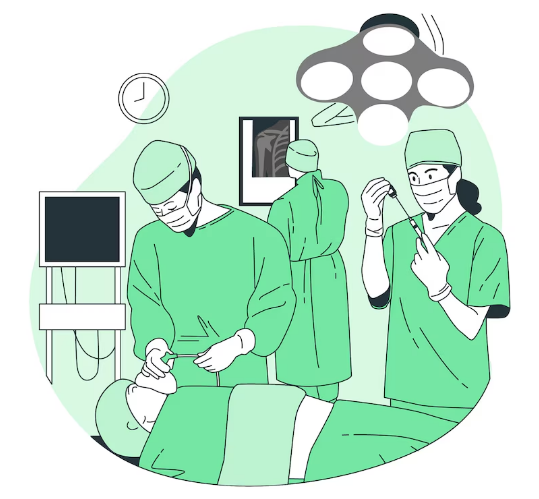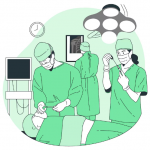Prefer to listen? Check out my podcast here!
Knowing what to do to prepare a person using GLP1 based medication for surgeries requiring anesthesia, or procedures requiring sedation (like colonoscopy, or sedation for MRIs in people with anxiety) remains a clinical conundrum. GLP1 based medications are used for treatment of diabetes and for weight management, and include semaglutide (Ozempic / Rybelsus / Wegovy), tirzepatide (Mounjaro / Zepbound), liraglutide (Victoza / Saxenda), dulaglutide (Trulicity), and others.
As blogged previously, some case reports have emerged where people taking GLP1 based medications had been found to have food in the stomach despite following the usual fasting procedures, and even cases of aspiration of stomach content into the lungs, which can be life threatening. Guidance from different organizations (mostly anesthesiology and gastroenterology) subsequently emerged with different instructions for if and how long to hold GLP1 medications before sedation or anesthesia.
As these guidance papers tended not to agree, new multisociety clinical practice guidance was just published in an attempt to harmonize recommendations. It was developed, approved, and/or affirmed by several gastroenterological, obesity surgery, and anesthesiology societies. (Note the absence of any endocrinology (diabetes specialist) societies on this list.) Note that this is not a guideline, as guidelines require evidence from clinical trials to back them up. In this area, there just isn’t much data to go on.
So what does this guidance document recommend?
For their first recommendation, they state that use of GLP1s in the perioperative period (or not) should be based on shared decision making. In this decision making, they recommend considering that:
- The escalation phase of medication is associated with higher risk of delayed stomach emptying. (I fully agree)
- A higher dose makes gastrointestinal (GI) side effects more likely (agreed that the risk of GI side effects is higher with higher doses)
- GI side effects are more common with weekly meds than daily (note: I don’t agree. Oral semaglutide (Rybelsus) is once daily, but has the half life of a weekly medication, with the numbers suggesting a greater likelihood of GI side effects than studies of some of the older daily medications.)
- If a person has GI symptoms, this suggests delayed gastric emptying. (I agree)
- Consider other medical conditions that could delay gastric emptying. (I would add to that – consider other medications that could delay gastric emptying as well, like narcotic pain meds, some antidepressants, calcium channel blockers (blood pressure medication), and marijuana, to name a few.)
If it is determined that an individual has an elevated risk of delayed gastric emptying, they recommend balancing the surgical and medical risk of holding (or not) GLP treatment . They recognize that holding medication could come with serious risks like running high blood sugars in people with diabetes (important to avoid this going into any surgery), and that bridging medication (eg insulin) comes with risks (like low blood sugars). I’m glad they point out that it is not appropriate to just blanket hold medication in people using GLP1 medication as an obesity treatment, as this is stigmatizing against obesity (not to mention there is not data to support this approach).
If the decision is made to hold GLP1 medication before a procedure, acknowledging that the duration to hold medication is unknown, they suggest following the original American Society of Anesthesiology guidance to hold medication one week prior to procedures for weekly formulations, and holding the day of surgery for daily formulations. As blogged previously, I (and many of my endocrinology/obesity medicine specialist colleagues) still don’t feel that this approach has much merit. About 50% of the full level of medication will still be present after holding for those durations of time, which to me really doesn’t accomplish much other than perhaps providing some unfounded reassurance for the health care team. I point out again that oral semaglutide (Rybelsus) is a daily medication but has the half life (duration of activity) of a weekly medication, so oral semaglutide should follow the guidance of the weekly medications.
I was pleased to see their second recommendation focusing on modifications to the preoperative diet, with guidance for preoperative liquid diet for at least 24 hours before anesthesia or sedation when there is concern for delayed gastric emptying based on the risk assessment checklist above. (Note that for people with diabetes, some medications (like insulin or sulfonylureas) may need to be adjusted to avoid low blood sugars during this dietary alteration.)
If there is concern for retained gastric contents on the day of the procedure, gastric ultrasound can be helpful (if available) to assess aspiration risk. They suggest that an altered anesthesia plan can also be incorporated into the plan (eg rapid sequence induction).
They state that safe continuation of surgery and endoscopy can be prioritized following their recommendations, as would occur with other patient populations with gastroparesis. I want to point out here that slowing of the gastrointestinal tract on GLP1 medications does NOT constitute a diagnosis of gastroparesis (as blogged previously).
At the end of the day, I do appreciate the attempt to provide guidance to support best decision making for each patient. I feel that the main step forward here is a specific recommendation that includes a longer preoperative liquid diet. Without good clinical trial evidence, we are unfortunately still left with more questions than answers.
Check me out on X/twitter! @drsuepedersen
Share this blog post using your favorite social media link below!
www.drsue.ca © 2024












